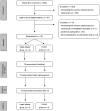Accelerometry measuring the outcome of robot-supported upper limb training in chronic stroke: a randomized controlled trial
- PMID: 24823925
- PMCID: PMC4019639
- DOI: 10.1371/journal.pone.0096414
Accelerometry measuring the outcome of robot-supported upper limb training in chronic stroke: a randomized controlled trial
Abstract
Purpose: This study aims to assess the extent to which accelerometers can be used to determine the effect of robot-supported task-oriented arm-hand training, relative to task-oriented arm-hand training alone, on the actual amount of arm-hand use of chronic stroke patients in their home situation.
Methods: This single-blind randomized controlled trial included 16 chronic stroke patients, randomly allocated using blocked randomization (n = 2) to receive task-oriented robot-supported arm-hand training or task-oriented (unsupported) arm-hand training. Training lasted 8 weeks, 4 times/week, 2 × 30 min/day using the (T-)TOAT ((Technology-supported)-Task-Oriented-Arm-Training) method. The actual amount of arm-hand use, was assessed at baseline, after 8 weeks training and 6 months after training cessation. Duration of use and intensity of use of the affected arm-hand during unimanual and bimanual activities were calculated.
Results: Duration and intensity of use of the affected arm-hand did not change significantly during and after training, with or without robot-support (i.e. duration of use of unimanual use of the affected arm-hand: median difference of -0.17% in the robot-group and -0.08% in the control group between baseline and after training cessation; intensity of the affected arm-hand: median difference of 3.95% in the robot-group and 3.32% in the control group between baseline and after training cessation). No significant between-group differences were found.
Conclusions: Accelerometer data did not show significant changes in actual amount of arm-hand use after task-oriented training, with or without robot-support. Next to the amount of use, discrimination between activities performed and information about quality of use of the affected arm-hand are essential to determine actual arm-hand performance.
Trial registration: Controlled-trials.com ISRCTN82787126.
Conflict of interest statement
Figures





References
-
- Broeks JG, Lankhorst GJ, Rumping K, Prevo AJ (1999) The long-term outcome of arm function after stroke: results of a follow-up study. Disabil Rehabil 21: 357–364. - PubMed
-
- Nichols-Larsen DS, Clark PC, Zeringue A, Greenspan A, Blanton S (2005) Factors influencing stroke survivors' quality of life during subacute recovery. Stroke 36: 1480–1484. - PubMed
-
- Wolfe CD (2000) The impact of stroke. Br Med Bull 56: 275–286. - PubMed
-
- Prange GB, Jannink MJ, Groothuis-Oudshoorn CG, Hermens HJ, Ijzerman MJ (2006) Systematic review of the effect of robot-aided therapy on recovery of the hemiparetic arm after stroke. J Rehabil Res Dev 43: 171–184. - PubMed
-
- Page SJ, Gater DR, Bach YRP (2004) Reconsidering the motor recovery plateau in stroke rehabilitation. Arch Phys Med Rehabil 85: 1377–1381. - PubMed
Publication types
MeSH terms
Associated data
LinkOut - more resources
Full Text Sources
Other Literature Sources
Medical

